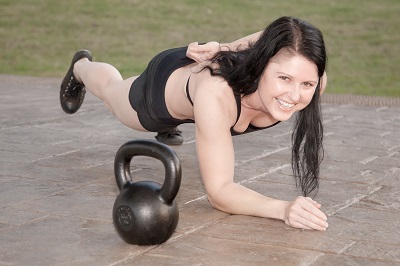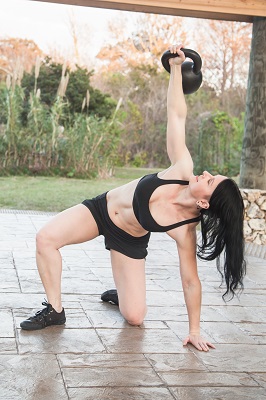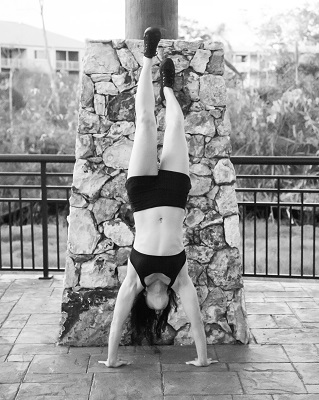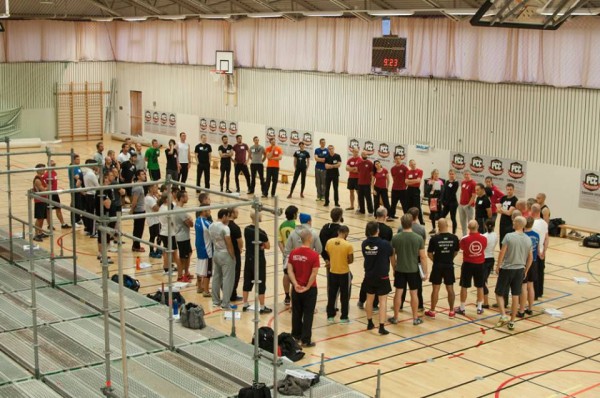
The fact of Going To Sweden hadn’t fully hit me until the plane landed in France for a connection, and I stopped hearing English. As soon as I stepped off the plane in Gothenburg, it was immediately evident that Sweden was different. I’d never been to Scandinavia and despite the jet lag and lack of sleep was incredibly impressed by the gorgeous and efficient little airport—it was obviously the product of many smart people thinking about how to make it gorgeous and efficient. Even baggage claim was impressive, with three organically shaped baggage claim belts next to full sized tree statues featuring carved “leaves” and a pair of electric plugs at the base for charging phones. The plugs were labeled to indicate the power was even from a green source. After exiting with no hassle or passport stamping—which was a little disappointing since I wanted a Sweden stamp—our host, Fredrik Högström with Al and Danny Kavadlo were waiting and ready to go!
Not even 10 feet outside the airport, we’re already back in our habit of scouting out found items for flags, l-sits, and adventurous pistols. Before we reached the parking lot, Danny did a great human flag on a cool sculpture/planter topped with ornamental cabbages. As Fredrik drove us to town, Al, Danny and I wondered at the landscape as it slipped by on our way to downtown Gothenburg. The trees were different, cars were different, the roads were different, and of course we asked Fredrik about all of it.
After checking in and dropping off our bags at the hotel, Fredrik took us to lunch. Our first meal in Sweden would be Thai and it was delicious. We asked how to say “please and thank you” in Swedish (tack), as well as the words for beef (biff) and chicken (kyckling—which is fun to say for some reason). Espresso is espresso in Swedish, and chocolate “choklad.” After learning please, thank you, beef, chicken, espresso, and chocolate I felt fairly confident.
The lunch had energized us all, and even though Al, Danny and myself had been traveling for hours (my journey involved 3 airplanes), we decided to walk around Gothenburg to adjust to the time change. Almost immediately, the Kavadlo brothers snapped into action and began scouting places for awesome feats of bodyweight strength. The sun was out and so were our cameras. We started in with human flags, L-sits, and dragon flags, taking advantage of the good lighting.
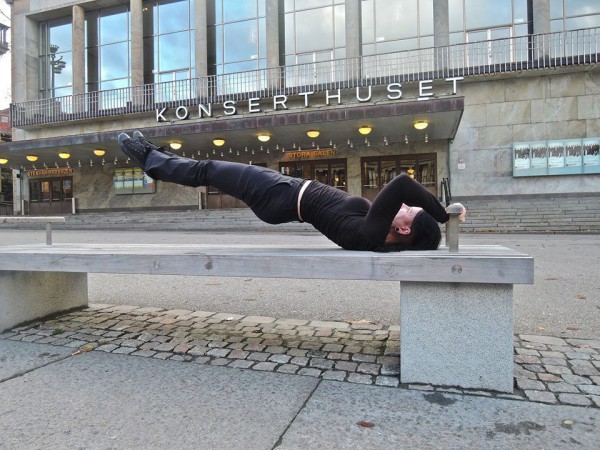
It was amazing to see Al and Danny’s endurance was still strong after nearly no sleep and all the traveling. At the time it seemed a little crazy to do these things after so little rest, but it ended up being well timed since the sun wouldn’t be out for the rest of the trip and darkness descended very early. Thankfully the three of us had arrived a couple days early to adjust to the time change. We wanted to really be “on” to lead the physically and mentally demanding PCC Workshop, especially since this was the PCC’s international debut.
After coffee and some organizational planning, Fredrik took us on a tour of his gym, Kettlebell Center. We loved the giant pegboard, stall bars, pull up bars, kettlebells, giant battling rope—and of course we had to play with everything. A trainer named Hillevi was finishing up with her group class which involved a very serious circuit. I was excited to meet her as she was one of the women attending the workshop. So far, it’s been mostly men at the workshops, and I want to encourage more women to attend. The range of exercises covered at the PCC are fantastic for any and everybody as are the progressions. The women who do attend are often surprised at how well they can perform some of the progressions and master steps.
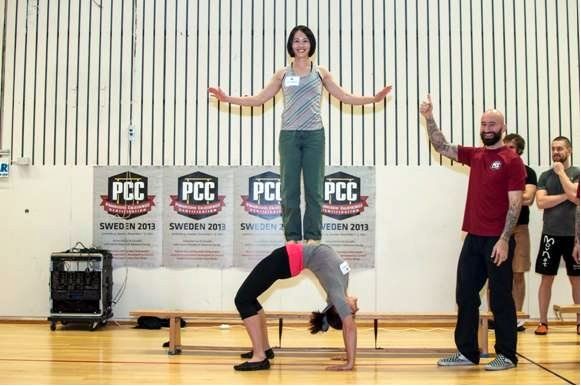
On Friday morning we could hardly wait to get started. The thing I first noticed about the participants was how excited they were and the variety of body types. Everyone looked very athletic, but it was obvious that there were a number of different specialists and athletes in attendance. This is something which can really bring a lot of value to workshops—a variety of athletic backgrounds and different skill and strength attributes. It’s a great opportunity to test out new cues, coaching and teaching approaches, and of course to learn from their experiences. Something I find fascinating are very mental cues. I wasn’t sure how many of these cues would be language dependent, so this would be very interesting.
We began the PCC in the classic Dragon Door way by gathering into a huge circle in the middle of the gym. After a greeting from John Du Cane, everyone in the circle introduced themselves. As expected, some of the best trainers in Sweden were in attendance along with accomplished trainers both in the RKC and new to Dragon Door who traveled from all over Europe. Amazingly, we also had someone attend from as far away as Kuwait!
Even though nearly everyone spoke perfect English, I still wondered how the nuances of our instruction would translate. But yet again, the universality of the strength and movement ideas we were teaching overcame any small language differences with ease. Since many of the attendees were accomplished fitness professionals from various fields (kettlebells, martial arts, calisthenics, yoga), this universal language of movement and strength was even more evident.
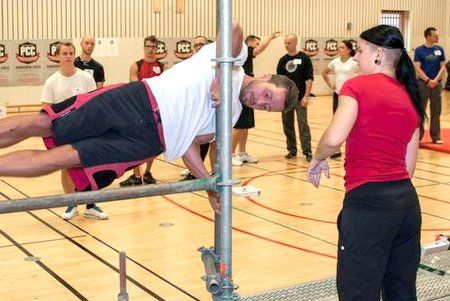
On the first day, when I was coaching someone with their clutch flag, I was reminded of a favorite “translation” between exercises. While helping someone at a previous PCC, I noticed exactly how much the clutch flag and the one arm elbow lever have in common. During a break in St. Paul, I played with the clutch flag and elbow lever together. Setting the angle of the bottom arm grasping the pole for a clutch flag, then keeping that same position, I came away from the pole and immediately tried the 1 arm elbow lever on the ground. For my particular build, the positioning was exactly the same, and have found it to be this way for some other people as well. Why mention this previous PCC realization/cue? Because it’s very easy to explain with just a few gestures and words. The way it translates itself will also depend on someone’s athletic background. Yoga practitioners tend to immediately grasp the idea because of how it relates to similar movements—even though the clutch flag might have previously given them some difficulty since being sideways while clinging onto a pole is incredibly strange at first. Pointing out the similarities between the two moves has been useful for coaching the clutch flag or the 1 arm elbow lever, whichever of the two they perform or understand best is the place to start.
Even though it’s incredibly rewarding to help people with the pull-up, I must admit to really enjoying coaching the flag. The attendees of the PCC in Sweden were very advanced with their own training, and while we love discussing how to help their clients progress with specific coaching methods, it’s incredibly fun to figure out just the right cue, combination of words, or exaggerated gesture to trigger their own success with a new move like the flag or clutch flag. While every attendee had a very solid grasp of the pull up, few people seemed to have given the clutch or press (human) flag much attention. Although it can be difficult to find an optimal place to practice flags, and because they’re sometimes dismissed as flashy “tricks”, I think the clutch flag and human flag have a lot to teach us. While it’s true that the human flag and clutch flag will always get attention when performed in public, the real value of the clutch and human flags are the proprioception, extreme tension, and control that they teach. The tension needed for the entire flag series translates into any full body drill, while really emphasizing lessons of body positioning and the extreme need for awareness of where all our “parts” are in space—while in a very unfamiliar plane!
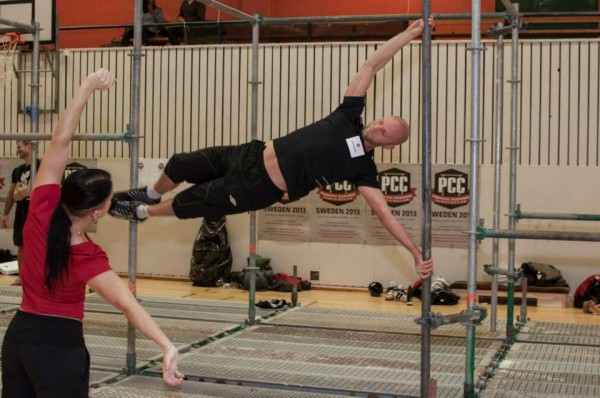
The human flag is such a maximal move that every muscle is involved, and at least for some of us, total concentration is required. It’s easy to forget this when Al or Danny demonstrates the flag. Their polished performances hide the fact that they worked, struggled, and practiced the flag for many years. Over a coffee break, I asked Danny to tell me how long he’s been working on his amazing human flags—and the answer (thankfully) was for a lot longer than I would have guessed. Another reason that it is so fun to coach the clutch and human flags at the PCC is the potential for troubleshooting. With the participant on his or her side and in the air, this is often a completely new experience even for seasoned instructors/coaches/athletes/enthusiasts. The flag series can’t be accomplished with brute strength alone, and while you must be strong to do the clutch flag, it’s not the whole story. The clutch flag is also very interesting since it is so body dependent—different builds need to adjust for their own situations.
It was great to see that everyone not only easily understood all of the instructors, but really seemed to excel with their movements and coaching while at the first European PCC Workshop. Paul Wade’s ideas were NOT lost in translation.
***
About Adrienne Harvey, PCC Team Leader, RKCII, CK-FMS, Primal Move Nat’l Instructor: Originally RKC Certified in 2010, and RKC Level 2 certified in 2011, kettlebell and bodyweight training have been crucial in Adrienne’s personal quest for fitness. A core member of the PCC team, Adrienne loves sharing her knowledge with small groups and individuals. She also loves to develop recipes and workout programs to further support performance, body composition, and of course—FUN. Go to http://www.giryagirl.com/ for more information about Adrienne!
